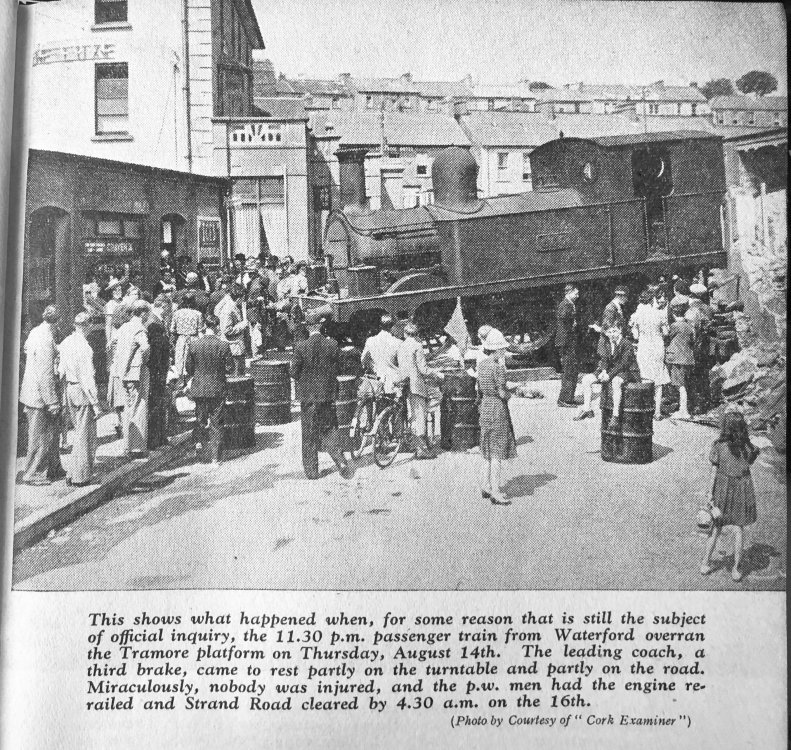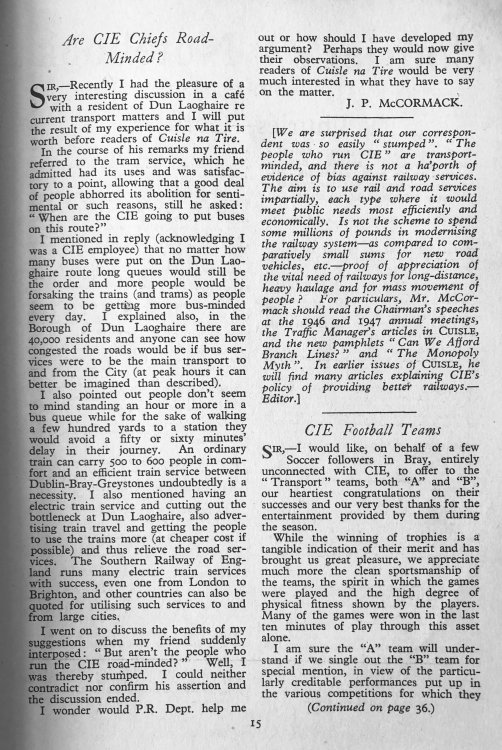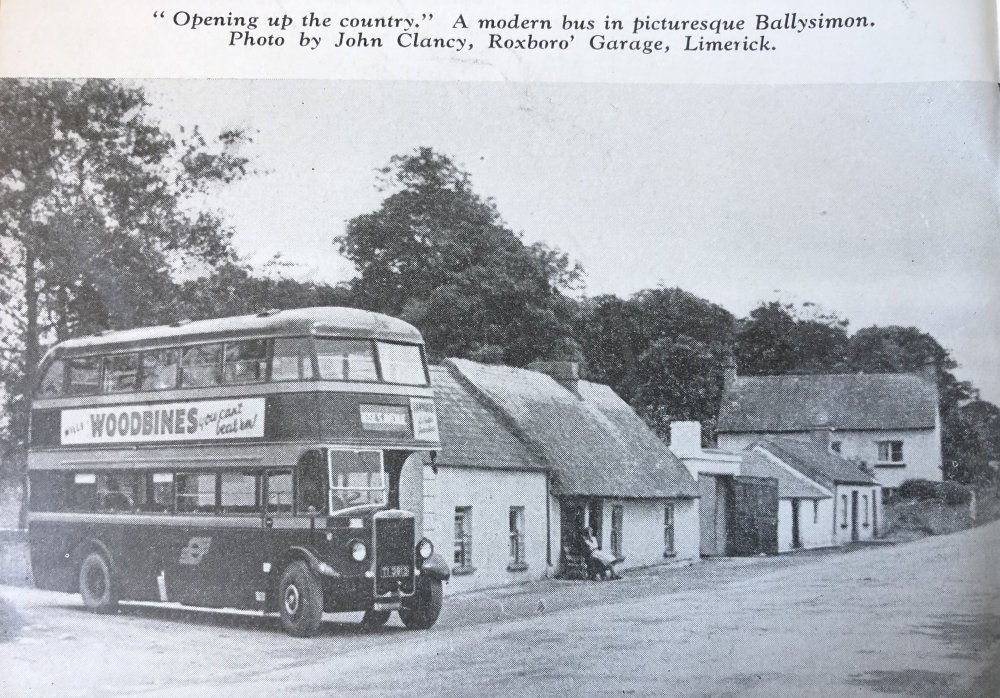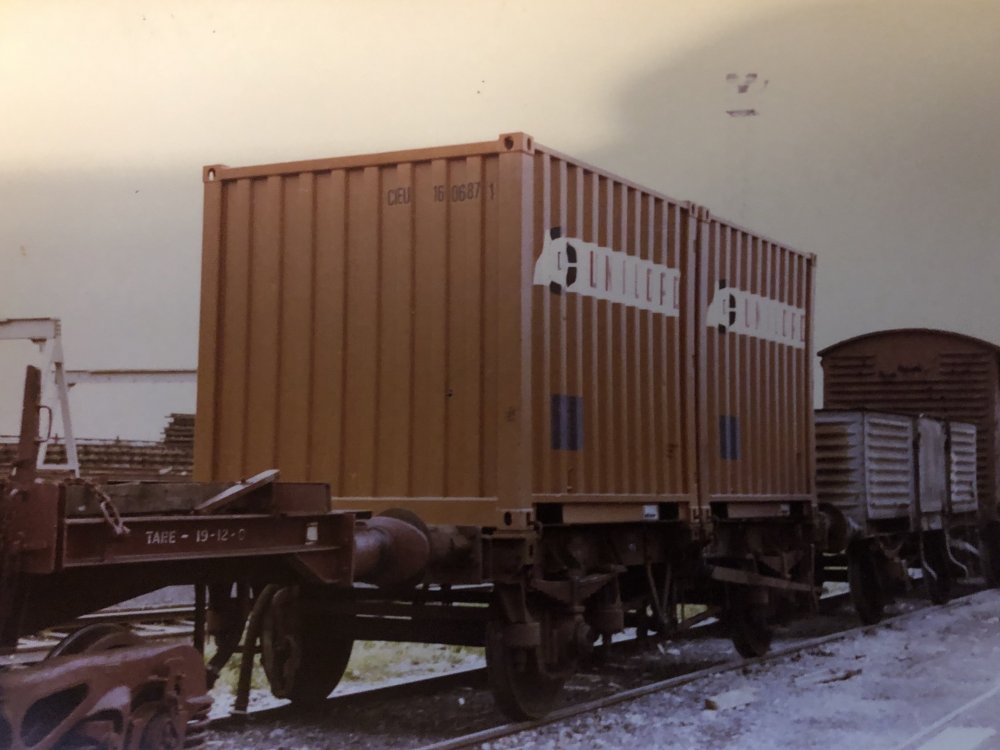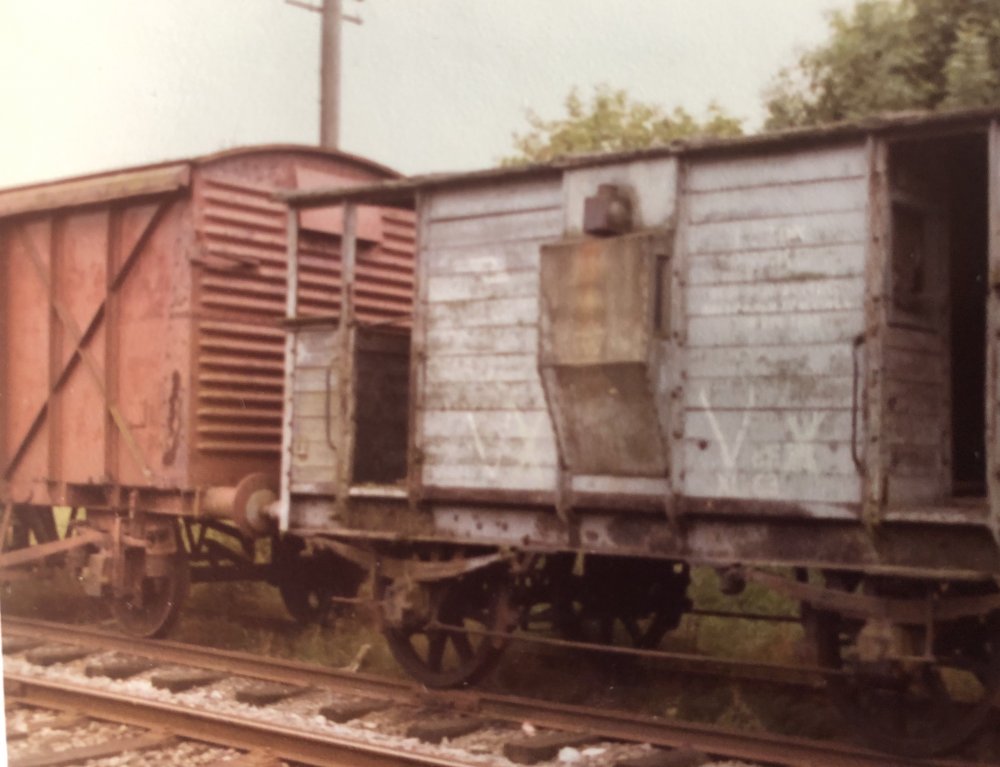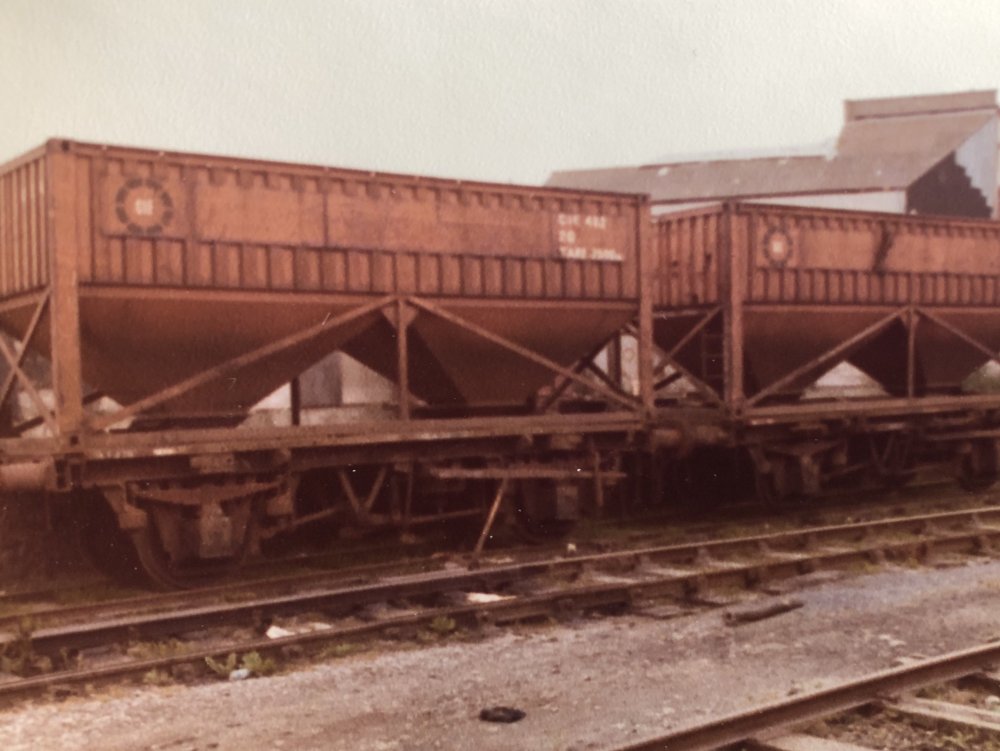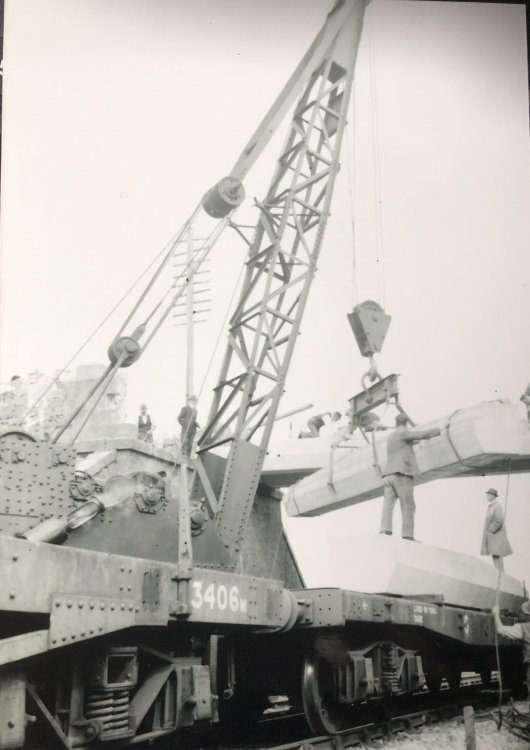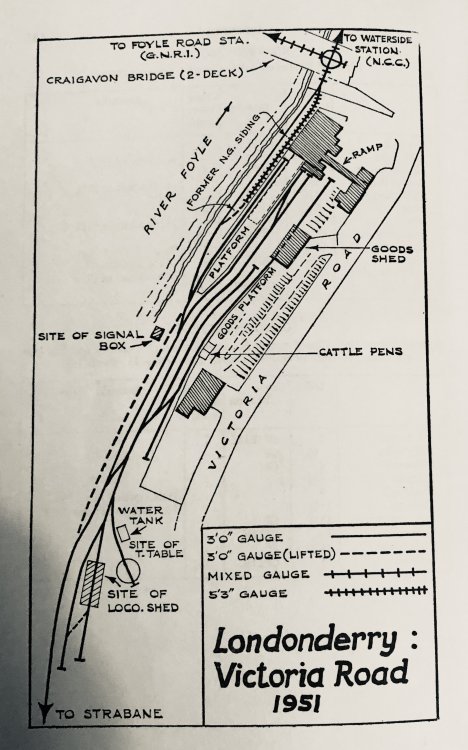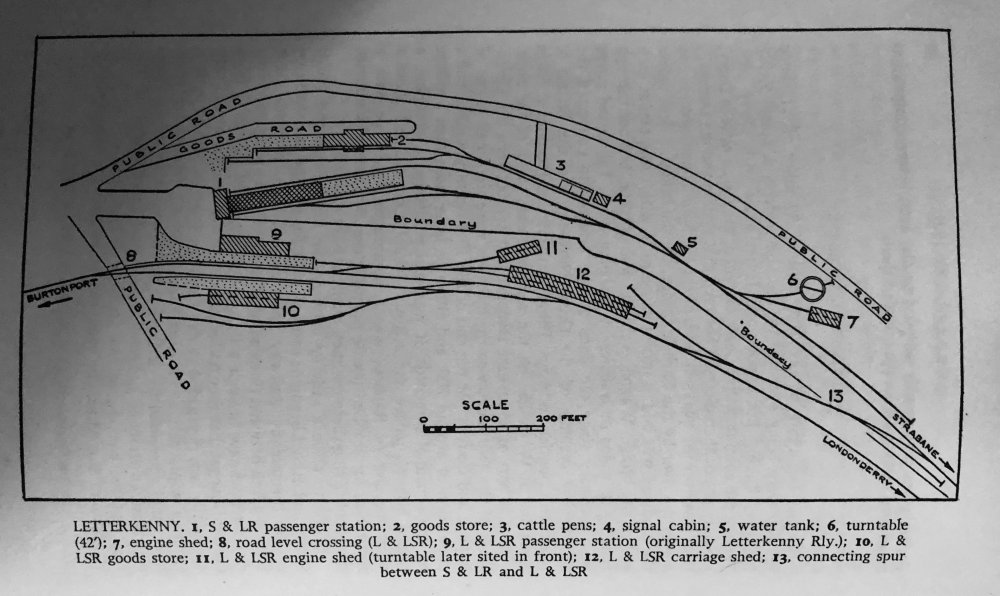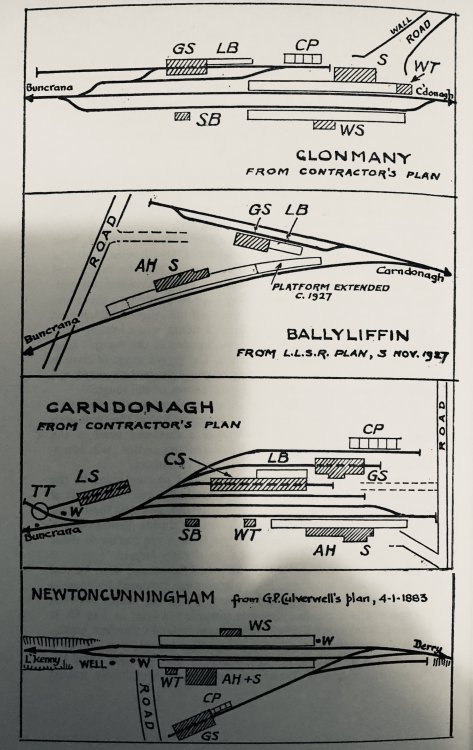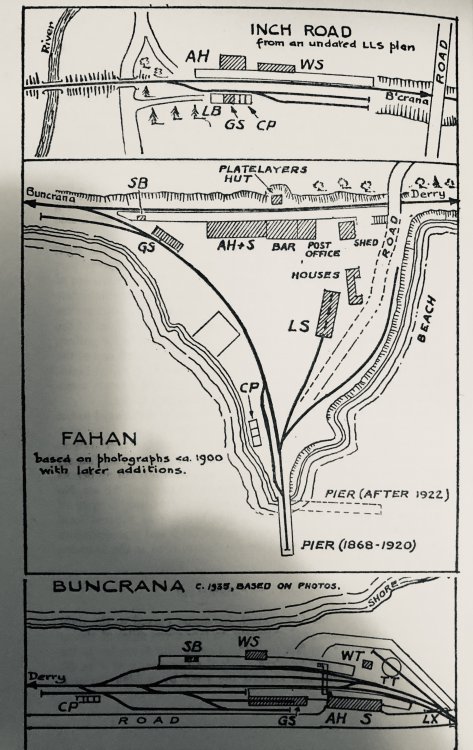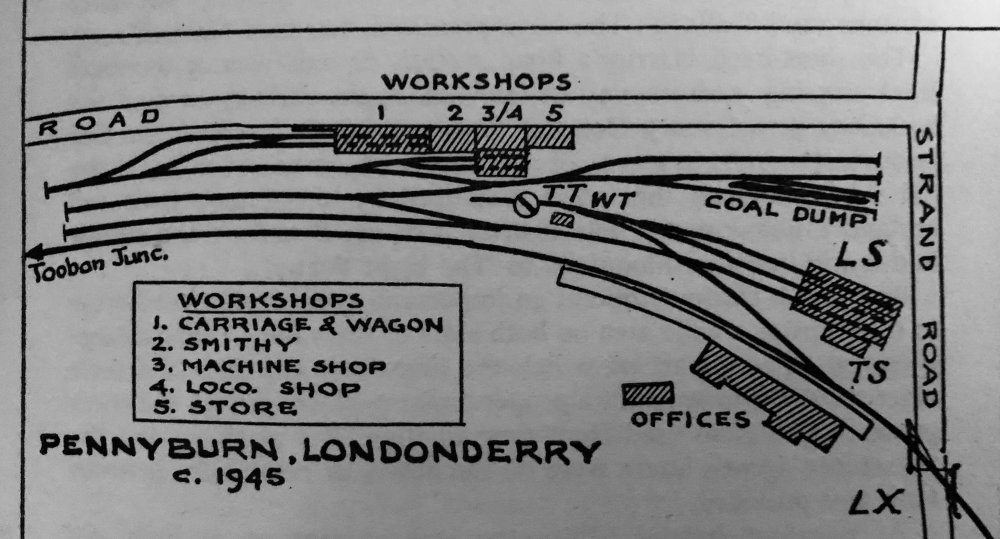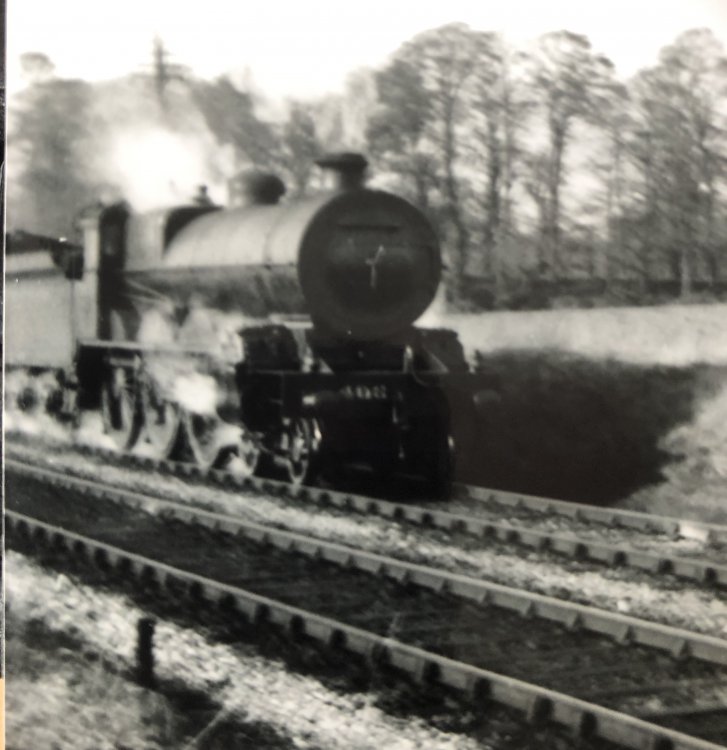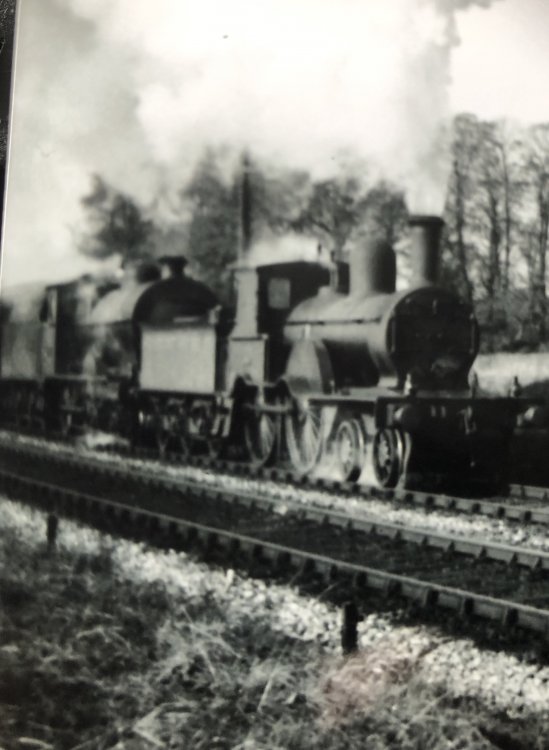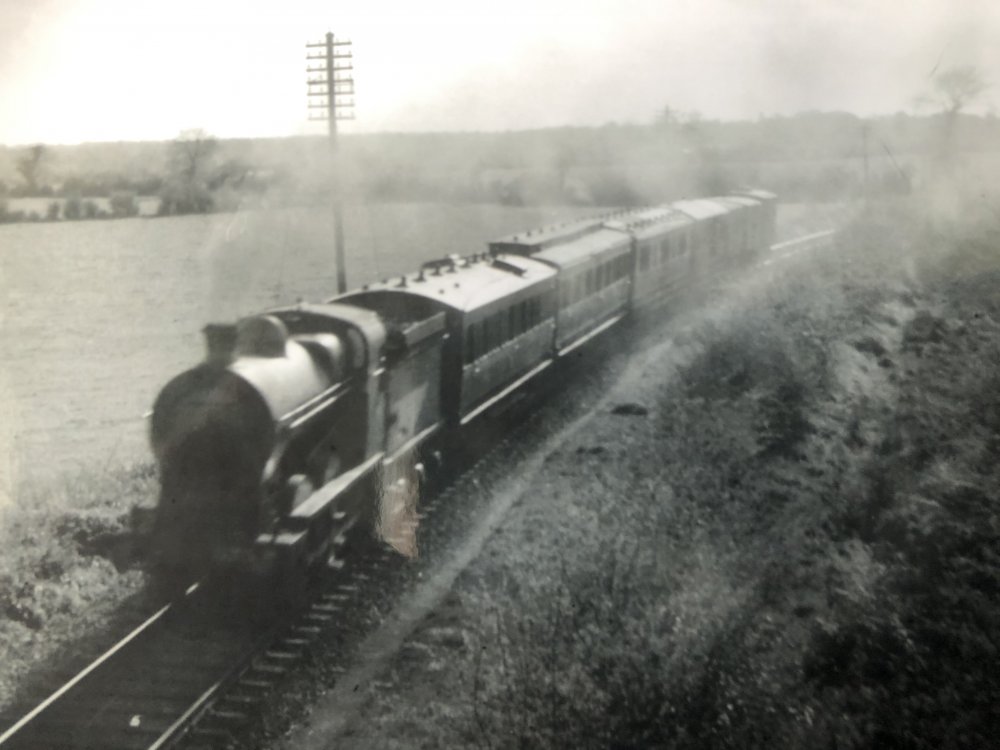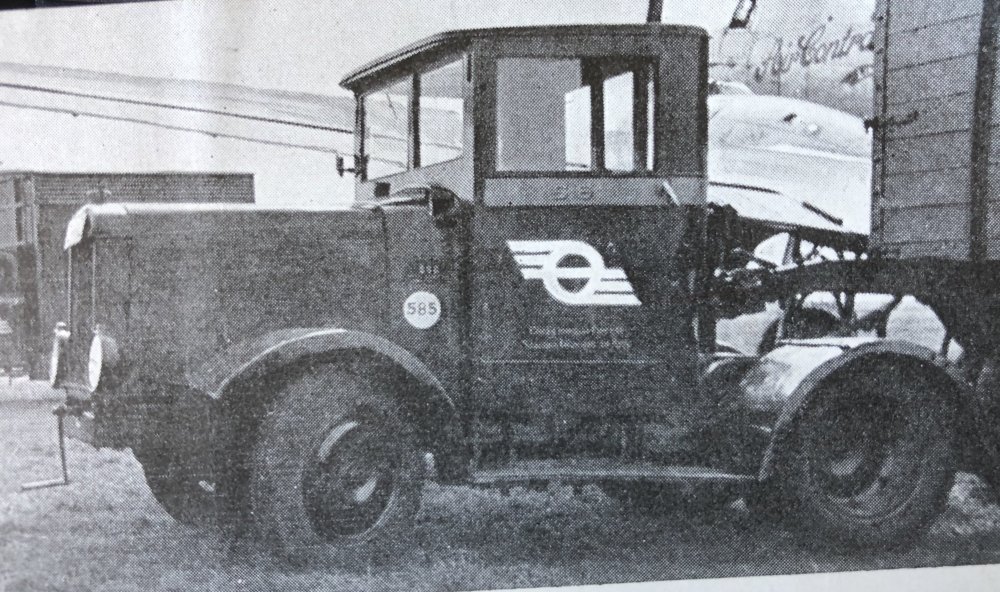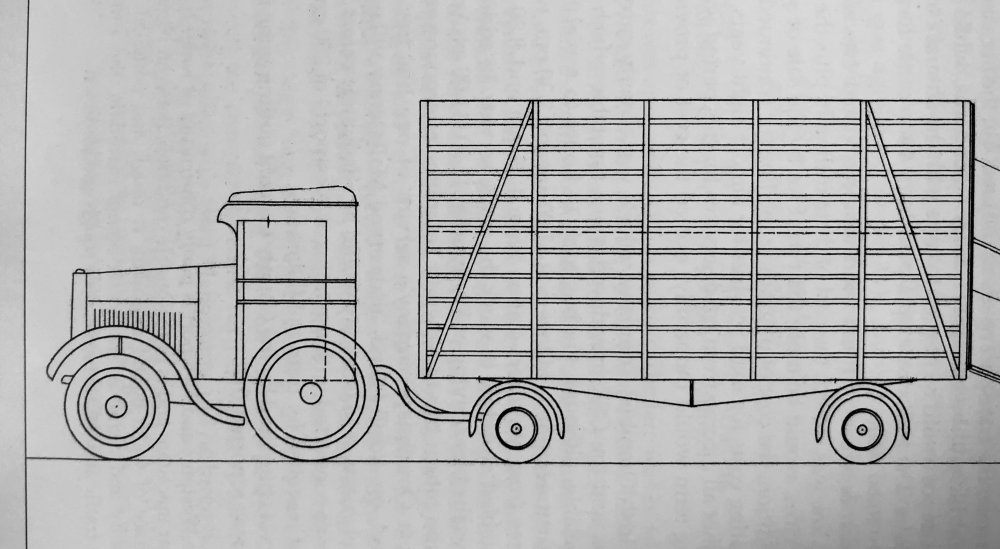-
Posts
15,849 -
Joined
-
Last visited
-
Days Won
393
Content Type
Profiles
Forums
Events
Gallery
Everything posted by jhb171achill
-
Most Donegal coaches were, over buffers, about 32ft. No. 1, the surviving 6-wheeler, was shorter, and obviously the NCC ones were longer. For 11 coaches you could be looking at very approximately 115 yards platform length.
-
There was nowhere to stop! The line simply consisted of the two stations, Waterford and Tramore, nowhere in between. Three locos were converted like the one shown, and the trio replaced the older Tramore locos, until the diesel railcars arrived in the fifties. Then they went back to the main system.
-
In those days, nobody worried unduly if a train was a bit longer than a platform - I recall getting out of a long train, down onto the ballast, even at Finaghy, outside Belfast, one time! Thus, you might get an 11-coach train in a station designed for nine! I looked in the Patterson CDR history to see what the platform length was, but it is not mentioned as far as I can see. An actual scale model, as you will know, of even a moderate-sized platform would be long on a model.
-
-
I couldn't swear to "never", but I certainly didn't ever either see or hear of a container like that with "BULK" written on it as well as "Bell", in Ireland.
-
You're right about some getting into the Bretland train - I suspect that the one I saw in the late 1960s was one such - it certainly looked as much like the above as I am capable of remembering. War surplus makes perfect sense - I had an idea in the back of my mind about them originating about then - must have read it somewhere before!
-
Yes, and if we look at that parapet, it seems that the left hand side of it is old stone masonry, while the right is newer block masonry. Clearly they are rebuilding a bridge. Could be anywhere. It is possible, that once I match up his notes with all (rather than just some!) of his pictures, I may be able to find out. I wonder can anyone, meantime, help with 3406M? Similar to the wagon to the right, very "American-looking" bogie rail flats. I recall seeing one derelict many many years ago somewhere round the North Wall area. Senior pointed it out to me.
-
Almost ten years before Todd Andrews and the massive railway closures of 1959-63, this article was written. It’s in a 1947 Cuisle issue. Then as now it appears that the government was suffering from what I call “Clonmel Syndrome”; using any means possible to get people out of trains and onto buses! (Look at the rail service Clonmel - one train a month, weather and horoscopes permitting, from that day to this......! Will the coronavirus finally finish the Limerick Junction - Waterford Line? Well, a vintage green CIE bus might provide a little compensation!
-
- 1
-

-
A few 1970s wagons and a puzzle. 1. 1978 - Heuston 2. The bubbles need no introduction here! This one has been factory-weathered by IRM.... 3. I think I’ve shown this before, but anyway..... GSWR guards van, Tralee, 1978 4. Barrier wagon - a silver painted container. Lurking in a siding at Heuston goods (I think), c.1968. Were these on the Asahis? 5. Grain wagons, Tralee, Rock St - again, I may have posted before. 6. The puzzle. One of Seniors. Other than the fact that it’s obviously a MGWR wagon with those distinctive bogies, all I know about this picture is that it dates from the late 1930s / early 1940s. I’ve no idea where it is, nor what the new concrete beams are. I do know that senior’s first ever job in his career was having some concrete beams installed at Mullingar station, but they were smaller than these.
-
The thing is, I believe, that each layout is it's owner's kingdom. Some prioritise scenery, some operational accuracy, some the engineering accuracy or complexity of a model, some crave absolute visual accuracy. None are wrong and none are right - it's a matter of personal opinion. Lately, the late Drew Donaldson's huge layout has been mentioned. The one time I saw it operate, I don't recall any scenery at all, yet the models were built to a very high standard indeed, for the time. Yet, almost all were in the wrong livery - a bit like much of the real-life preserved stuff! Personally, as will be very clear from anyone who reads my demented ramblings here, the visual aspect is what I personally enjoy - that can mean highly realistic scenery, and well-proportioned models which would naturally be in an accurate livery - but that's just me. Arising out of that, on a website such as this, if you've an engineering issue, the likes of Mayner and ecmtrains and others here will be along to share their expertise and knowledge. various among us who have a good historical knowledge can share that too. If I have access to information about liveries (and I have a huge lot of such stuff, because I've been making notes of it for forty years) I am pleased to share it! But, as I say, that's only my take on the whole hobby which as others have noted, is a very varied one. There are a million ways to skin a cat, and the creation of an overall atmosphere, I think, is yet another great skill that the hobby includes; your outdoor layout has that in lorry loads!
-
Looks superb, DSERetc. Really captures the steam era!
-
This took me greatly by surprise. Mention of the Castlemungret branch - in 1947! It wasn't opened until over ten years later! I had no idea it was even being thought if then.....
-
The thing about the Midland in the GSR era, like much at that time, in order to add colour, you're looking at carriages. Every single solitary item of goods stock, and every single solitary locomotive were all dull grey, often liberally "weathered"! The GSR did tend to keep locomotives clean, which made the grey look OK, a bit like the 071s right now - a dirty one just looks awful, but a clean one, well, OK or even good, on a clean sunny day! So, if you go back to the 1930s, you have three potential carriage liveries as oases in a sea of fifty-five shades of grey (yes, funny people out wesht). - 6-wheelers, Branch line and secondary stock - some still in the old very dark shade that the GSR inherited from the GSWR and splashed over everything from the Wisht Clare to main line Cork. In model form, you need some mix of a very dark maroon and a very dark chocolate brown, the reddish tint distinct but not much more. Weathered, they looked almost black at times. - 6-wheelers, Branch line and secondary stock - if repainted in recent times (since 1933) the same bright maroon as used by the LMS in England, and by extension the NCC. Right down to the same lining, though different crest and markings. Some secondary stock had no lining (same on NCC!). - Main line bogie stock - a very few still in the old dark "crimson lake" colour described above, a few in (English) GWR-style chocolate and cream - a short-lived main line livery current from about 1927/8 to 1934 or so - but most in the LMS livery. The horse box will either be a totally weathered brake dust colour, the sides looking like this extremely dark brownish red, but really very heavily weathered indeed, or possibly quite tidy LMS maroon. As far as I have ever become aware, no horse boxes were brown and cream - though it isn't beyond possibility that one or two might have got a coat of brown paint. I hope that is useful. By the way, once you go into CIE days, it's not until 1947 that any locos on the Midland become anything other than grey - and this means a few, but seemingly not all, of the "Woolwiches" and a couple of 4.4.0s. The rest.....grey, of course!
-
"Rails Through Connemara" is now ready, and but for the coronavirus shutdown would have been on the shelves in June - dear knows when it'll be now, but it shows more pics like that. If you are going for the late 1940s, there are two options for this van. 1. Reasonably clean looking and fairly recently painted in the new CIE livery of DARK green - not the late 1950s shade. If you look at the Bachmann train set with the "Woolwich" and set of coaches, or the background to my "avatar" thingy to the left, which is actual CIE paint, that is the shade for sides and ends. Roof very dark grey, almost black - or, indeed, dull matt black. Chassis matt black. Markings will have no "eau-de-nil" lines, but just the plain green, with the "flying snail" logo and a number. Being a Midland vehicle, this will end with "M", thus: 2M, 15M, 21M, or whatever. 2. For a horsebox, probably more likely not to be up-to -date, so still in old GSR livery. It probably won't see a paintbrush for a while yet - thus while technically GSR maroon (exact shade being British "LMS maroon"), it will probably not have been done up for ten years, so the chassis and roof will be an indistinguishable dusty weathered dirt colour, while the sides and ends will be a faded, dulled-down browny-reddish colour, the marking "G" "S" in small writing barely visible, with the number. The "GS" and number were in shaded gold letters, now faded to a dirty dull yellowy colour.
-
Horseboxes were a funny species from railway to railway! Usually they were painted in the "passenger" livery, as they spent a lot of time stuck on the end of passenger trains. That would mean maroon in GSR days, then green in CIE days. Since use of them fizzled out in the early 1960s, none ever were orange and black or any derivative of it, a bit like the last few passenger-carrying 6-wheel coaches. As an unrelated aside, this applied to NCC "brown vans" too. Never any lining though. As such, if in passenger livery, this extended to the chassis as well. So, for the GSR (or GSWR), maroon body, possibly light grey roof, and BLACK chassis, as per passenger stock. Once it's CIE time, plain green paint with very dark grey or black roof, and black chassis. One detail difference: CIE painted the ends of carriages black, not dark green - but horse boxes were green on both ends and sides. Now, nothing in life is ever simple - and judging from some photos I've seen, some CIE examples may have been plain wagon grey. I do not know what colours the NCC painted them. GNR, LLSR and CDRJC ones were plain wagon grey all over. BCDR ones were carriage maroon, possibly white roofs, and black chassis. The Midland Great Western probably painted theirs brown, as per carriages. It need hardly be added that none ever got the short-lived blue and white!
-
Here ye are, Colin: There are more, e.g. Strabane, Donegal and Killybegs, if you want - but that’s the ones you were looking for plus a few others.
-
Angus, I did a double take - that's N GAUGE!! Absolutely SUPERB job! It's either that or the 5p is 2ft diameter!
-
Funny, tonight I was perusing photos of various wagons for a forthcoming book and there were two I looked at (1950s) that while historically I know what colour they were, they are so utterly weatherbeaten, tatty and faded, dirty etc... for anyone who wasn't familiar with Irish railways you could tell them the thing had a pink chassis, lime green body, yellow buffers and a tartan patterned roof - and no-one could be any the wiser! I will be getting out my own stuff in the near future to weather it - I will practice on two tatty old GWR cattle trucks. If I could achieve half of the weathering skills of some of the folks here, I'd be well pleased. Since "Dugort Harbour" will be set in the mid-50s to mid-60s, and will be intended to represent somewhere on the very top of Todd Andrew's list for the chop, the weathering will almost be more important than the livery!
-
Looks just right - a liberal coating of gunk, dunduckety mud and brake dust! For about five seconds after leaving the paint shop, CIE and GSR wagons all carried the body colour on the chassis and roof too. Never black. Over time, the whole vehicle just got grubby looking all over, with rust showing on metal bits - all exactly as you've done above. In black'n'white photos, rust-covered metalwork has in more recent times misled many who never saw them in use, to see the BnW photo as depicting the ironwork in a much darker colour, assumed to be black; but not so. Roofs got darker due to loco exhausts. What you have looks good - I might try to disguise the roof a bit more as if it was initially painted the same grey, if I was to be absolutely obsessive! But it looks a great job - excellent weathering as always!
-
It would be great to see these two out again. Obviously the IOMR has to prioritise what brings money in, and that's steam engines and old wooden coaches, but the other side of the coin is their use in certain events, off-peak services, and what surely by now (with most work seemingly done) must be a reasonably low cost of finishing the job.... Put them in heritage CDR livery too!
-
Scooting along the main line near Hazelhatch..... I don't have dates or details for these, but they are mid 1930s. In the case of the third photo, the location also is unknown. Possibly on the Midland, looking at the vans. The leading coach in th it a train is of interest to me - I can’t quite place it. The second, an interesting clerestory 3rd, is GSWR of 1901/2 origin.
-
It is at Hilden Halt, just on the Belfast side of Lisburn. The vehicle about to be towed away is a 70 class driving trailer, which had been the rear vehicle of a three-coach all-stations to Belfast train. It had stalled there, first stop out of Lisburn, and a following train (which was an 80-class set) rammed it. Thankfully, it was a lightly-loaded service and nobody was killed (not as far as I recall, anyway), but had that been the 08:23 Lisburn to Belfast, it would have been packed-sardine-like to the doors, standing room only - and the result would have been unholy carnage. Without checking my notes, I think it was 1978. Around then, anyway. Once the police and railway officials had investigated the scene, the Hunslet, which had come in from Belfast, backed up and towed it away - slowly! There was another accident around the same time, about 18 months or so earlier, just a short way to the right in Lisburn station, when "A" class 010 on the up CIE "Enterprise" ran into the back of a stationary, and thankfully empty, 80 class set parked in the up platform in Lisburn station in its way. The driver had no time top react - he had a green signal. Signalling was manual then, and an error had been made in this area. A member of Lisburn station staff had the presence of mind to jump into the 80 when he heard the Dublin train coming and release the handbrake, to lessen the impact. Despite this, the "Enterprise" driver (from Connolly) was tragically killed as the cab of 010 just caved in. I saw that too - it was an extremely gruesome sight which I will never forget.
-
Cuisle na Tíre (“Ireland’s Transport Magazine”)
jhb171achill replied to jhb171achill's topic in General Chat
Old GSR / CIE Road Vehicles. These from a 1947 Cuisle. The older truck looks very like a thing my grandfather drew up for the GSR road services as a rough sketch of the sort of vehicle they could build to deal with cattle traffic following the closure of various branch lines. I reproduced the drawing in “Rails to Achill”. Apart from a larger wheel, the drawing of one of these things seem to bear some resemblance. -
I love this. A GNR man through and through who was born and bred deep in NCC land, but was never polluted in thought by York Road! ’Tis your parentage, Galteemore; it’s in the genes.....
-
This model is photographed in a 1940 mag, MM, so it refers to 1939. So the jury’s out! I would completely agree. Fry’s model, also, is of 800 in CIE livery, whereas the above purports to be 801, and in GSR livery.
.png.c363cdf5c3fb7955cd92a55eb6dbbae0.png)

